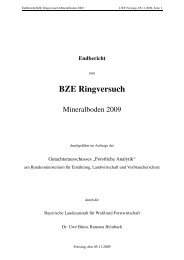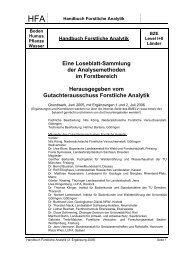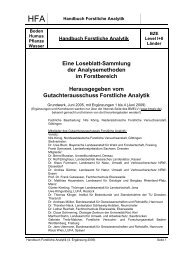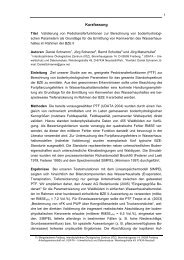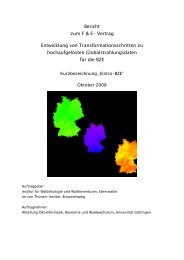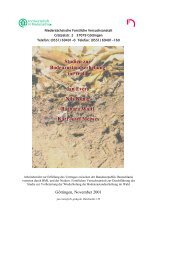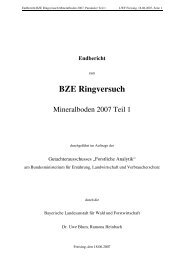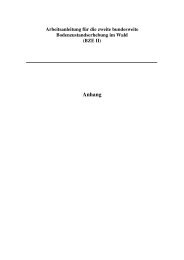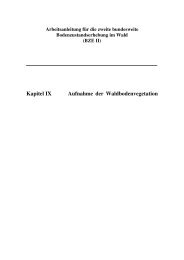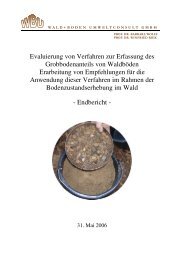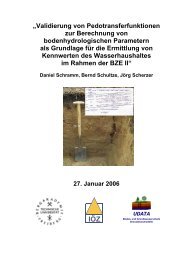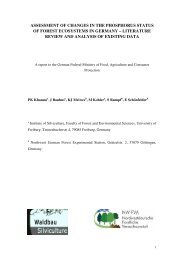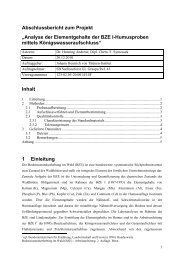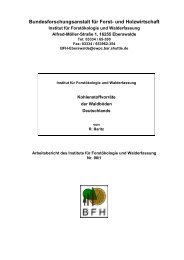assessment of changes in the phosphorus status of forest ...
assessment of changes in the phosphorus status of forest ...
assessment of changes in the phosphorus status of forest ...
You also want an ePaper? Increase the reach of your titles
YUMPU automatically turns print PDFs into web optimized ePapers that Google loves.
(e) strongly bound occluded Pi forms with<strong>in</strong> sesquioxides by strong HCl; (f) highly<br />
resistant Pi <strong>in</strong> secondary and primary m<strong>in</strong>erals.<br />
The fractionation methods are very widely used with different levels <strong>of</strong> success to<br />
assess P <strong>status</strong> <strong>of</strong> <strong>forest</strong> ecosystems. We present here <strong>the</strong> results <strong>of</strong> three case studies:<br />
(a) Compton and Cole (1998) compared P cycl<strong>in</strong>g between Douglas fir and red alder<br />
stands. Total ecosystem P <strong>in</strong> <strong>the</strong> alder stand was 69% <strong>of</strong> that found <strong>in</strong> <strong>the</strong> Douglas-fir<br />
stand (<strong>in</strong>herit site difference), but <strong>the</strong> alder stand took up 61% more P annually than<br />
Douglas-fir and also showed higher fluxes <strong>of</strong> P <strong>in</strong> litterfall (94%) and resorption<br />
(292%). But all <strong>the</strong> P extractable fractions, which are meant to represent available soil<br />
P, were lower under alder. They came to <strong>the</strong> conclusion that all static measures<br />
(pools) <strong>of</strong> available P do not appear to adequately reflect P supply <strong>in</strong> <strong>the</strong>se <strong>forest</strong><br />
stands.<br />
(b) B<strong>in</strong>kley et al. (2000) <strong>in</strong>vestigated P dynamics <strong>in</strong> Eucalyptus and Albizia pure<br />
species stands, and also <strong>in</strong> 1:1 mixture <strong>of</strong> <strong>the</strong> two species. A P fractionation technique<br />
with a slight modification (Fe impregnated paper) was used <strong>in</strong>stead <strong>of</strong> anion exchange<br />
res<strong>in</strong> to obta<strong>in</strong> easily desorbed P fraction - solution Pi. Eucalyptus had higher<br />
productivity, but both sites had similar amounts <strong>of</strong> P uptake at age 15 yrs. For most Pfractions<br />
<strong>the</strong>re was no effect <strong>of</strong> tree species except HCl-P, which was lower <strong>in</strong> Albizia<br />
than Eucalyptus soil (HCO3-Po was high <strong>in</strong> Albizia soil but NaOH was high <strong>in</strong><br />
Eucalypts). However, solution Pi was high <strong>in</strong> Eucalypts.<br />
(c) Richter et al. (2006) attempted to quantify <strong>changes</strong> <strong>in</strong> P fractions <strong>in</strong> an Ultisol<br />
dur<strong>in</strong>g <strong>the</strong> growth <strong>of</strong> an old-field p<strong>in</strong>e <strong>forest</strong> from 1957-2005. Soil sample were<br />
collected <strong>in</strong> 1962, 1968, 1977, 1982, 1990, 1997, and 2005 and different P fractions<br />
and available P us<strong>in</strong>g <strong>the</strong> Mehlich III method were determ<strong>in</strong>ed. The net transfer <strong>of</strong> P<br />
from m<strong>in</strong>eral soil <strong>in</strong>to tree biomass and O horizons was 82.5 kg ha -1 over a 28 year<br />
period (Table 10). However, this did not dim<strong>in</strong>ish <strong>the</strong> amount <strong>of</strong> labile soil P (anionexchange<br />
res<strong>in</strong>s, and NaHCO3 and Mehlich-III extractants). Substantial decreases <strong>in</strong><br />
slowly cycl<strong>in</strong>g Po and Pi associated with Fe and Al oxides and Ca compounds<br />
occurred dur<strong>in</strong>g 28 years <strong>of</strong> <strong>forest</strong> growth, and <strong>the</strong>se accounted for much <strong>of</strong> <strong>the</strong> P<br />
supplied to biomass and O horizons, show<strong>in</strong>g <strong>the</strong> long-term dynamics <strong>of</strong> P <strong>in</strong> soils as<br />
discussed above (Fig 11 ). Changes <strong>in</strong> soil P are small <strong>in</strong> this aggrad<strong>in</strong>g <strong>forest</strong> (2.9 kg<br />
ha -1 y -1 over 28 yr).<br />
66



